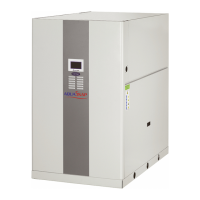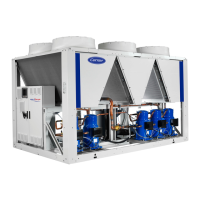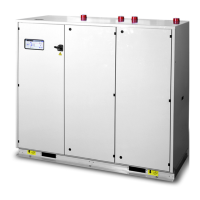47
9 - WATER CONNECTIONS
For size and position of the heat exchanger water inlet and outlet
connections refer to the certied dimensional drawings supplied
with the unit. The water pipes must not transmit any radial or axial
force to the heat exchangers nor any vibration.
The water supply must be analysed and appropriate ltering,
treatment, control devices, isolation and bleed valves and circuits
built in, to prevent corrosion, fouling and deteriora-tion of the pump
ttings. Consult either a water treatment specialist or appropriate
literature on the subject.
9.1 - Operating precautions
Design the water circuit with the least number of elbows and
horizontal pipe runs at different levels. The main points to be
checked for the connection are:
- The use of different metals on hydraulic piping could generate
eletrolytic pairs and consequently corrosion. Verify then, the
need to install sacricial anodes.
- Comply with the water inlet and outlet connections shown on
the unit.
- Install manual or automatic air purge valves at all high points
in the circuit(s).
- Use a pressure reducer to maintain pressure in the circuit(s)
and install a relief valve as well as an expan-sion tank. Units
with hydraulic module and option 293 or 293A include the
relief valve and expansion tank.
- Install drain connections at all low points to allow the whole
circuit to be drained.
- Install stop valves, close to the entering and leaving water
connections.
- Use exible connections to reduce vibration transmission.
- If the insulation provided is not sufcient, insulate the cold-
water piping, after testing for leaks, both to reduce heat loss
and to prevent condensation.
- Cover the insulation with a vapour barrier.
- If the external water piping to the unit is in an area where the
ambient temperature can fall below 0 °C, insulate the piping
and install an electric heater on the piping.
NOTE: For units without option 293 or 293A, a screen lter
must be installed as close as possible to the heat exchanger
and in a position that is easily accessible for removal and
cleaning. Units with a hydraulic module include this lter.
The mesh size of the lter must be 1.2 mm. If this lter is not
installed, the plate heat exchanger can quickly become
contaminated at the rst start-up, as it takes on the lter
function, and correct unit operation is affected (reduced water
ow due to increased pressure drop).
Damage due to absence of relief valve, expansion tank or
screen lter (i.e. without option 293 or 293A) is not covered
by the warranty.
ATTENTION: Use of units in an open loop is forbidden.
Before the system start-up verify that the water circuits are
connected to the appropriate heat exchangers (e.g. no
reversal between evaporator and condenser).
Do not introduce any signicant static or dynamic pressure
into the heat exchange circuit (with regard to the design
operating pressures).
Before any start-up verify that the heat exchange uid is compatible
with the materials and the water circuit coating.
If additives or other uids than those recommended by the manufacturer
are used, ensure that the uids are not considered as a gas, and that
they belong to class 2, as dened in directive 2014/68/UE.
Recommendations on heat exchange uids:
- No NH
4+
ammonium ions in the water, they are very
detrimental for copper. This is one of the most important
factors for the operating life of copper piping. A content of
several tenths of mg/l will badly corrode the copper over time
(the plate heat exchangers used for these units have brazed
copper joints).
- Cl
-
Chloride ions are detrimental for copper with a risk of
perforations by corrosion by puncture. If possible keep below
125 mg/l.
- SO
4
2-
sulphate ions can cause perforating corrosion, if their
content is above 30 mg/l.
- No uoride ions (<0.1 mg/l).
- No Fe
2+
and Fe
3+
ions with non negligible levels of dissolved
oxygen must be present. Dissolved iron < 5 mg/l with
dissolved oxygen < 5 mg/l.
- Dissolved silica: silica is an acid element of water and can
also lead to corrosion risks. Content < 1mg/l.
- Water hardness: > 0.5 mmol/l. Values between 1 and 2.5 can
be recommended. This will facilitate scale deposit that can
limit corrosion of copper. Values that are too high can cause
piping blockage over time. A total alkalimetric titre (TAC)
below 100 is desirable.
- Dissolved oxygen: Any sudden change in water oxygena-tion
conditions must be avoided. It is as detrimental to
deoxygenate the water by mixing it with inert gas as it is to
over-oxygenate it by mixing it with pure oxygen. The
disturbance of the oxygenation conditions encourages
destabilisation of copper hydroxides and enlargement of
particles.
- Electric conductivity 10-600µS/cm
- pH: Ideal case pH neutral at 20-25 °C - 7 < pH < 8
If the water circuit must be emptied for longer than one month,
the complete circuit must be placed under nitrogen charge to avoid
any risk of corrosion by differential aeration.
ATTENTION: Filling, completing and draining the water circuit
chargemustbedonebyqualiedpersonnel,usingthe air
purges and materials that are suitable for the products.
Charging and removing heat exchange uids should be done
with devices that must be included on the water circuit by the
installer. Never use the unit heat exchangers to add heat
exchange uid.
9.2 - Water connections
The diagram below illustrates a typical hydraulic installation. When
the hydraulic circuit is charged, use the air vents to evacuate any
residual air pockets.

